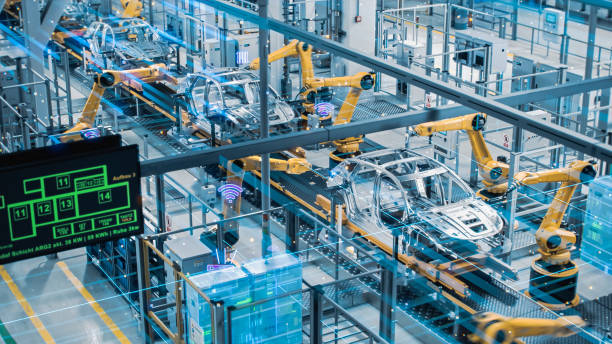Adaptive Manufacturing: Reshaping Production Paradigms
Adaptive manufacturing is revolutionizing industrial production, offering unprecedented flexibility and efficiency. This innovative approach allows companies to swiftly adjust their manufacturing processes in response to changing market demands, technological advancements, and unforeseen disruptions. By embracing adaptive manufacturing, businesses can optimize resource utilization, reduce waste, and accelerate time-to-market for new products.

The Evolution of Manufacturing Flexibility
The concept of adaptive manufacturing has its roots in the early days of mass customization. As consumer demand for personalized products grew, manufacturers began exploring ways to introduce greater flexibility into their production processes. The advent of computer-integrated manufacturing (CIM) in the 1980s laid the groundwork for more adaptable systems, but it wasn’t until the recent advancements in data analytics, artificial intelligence, and robotics that truly adaptive manufacturing became feasible.
Today’s adaptive manufacturing systems are characterized by their ability to rapidly reconfigure production lines, optimize processes in real-time, and even predict and preemptively address potential issues. This level of agility allows companies to respond quickly to market changes, experiment with new product designs, and efficiently produce small batches of customized items without sacrificing the economies of scale typically associated with mass production.
Key Components of Adaptive Manufacturing
At the heart of adaptive manufacturing are several key technologies and methodologies that work in concert to create a highly responsive production environment:
-
Advanced robotics and automation: Flexible robotic systems that can be quickly reprogrammed for different tasks.
-
Modular production lines: Easily reconfigurable workstations that can be rearranged to accommodate different product specifications.
-
Real-time data analytics: Continuous monitoring and analysis of production data to identify optimization opportunities and predict maintenance needs.
-
Digital twins: Virtual representations of physical assets that enable simulation and testing of process changes before implementation.
-
Additive manufacturing: 3D printing technologies that allow for rapid prototyping and production of complex, customized parts.
Implementing Adaptive Manufacturing Strategies
Transitioning to an adaptive manufacturing model requires careful planning and a comprehensive approach. Companies must first assess their current production capabilities and identify areas where increased flexibility would provide the most significant benefits. This often involves:
-
Conducting a thorough analysis of existing production processes and equipment.
-
Investing in scalable, modular production technologies that can be easily reconfigured.
-
Developing a robust data infrastructure to support real-time monitoring and analytics.
-
Training employees in new technologies and encouraging a culture of continuous improvement and adaptability.
-
Establishing partnerships with technology providers and industry experts to stay at the forefront of adaptive manufacturing innovations.
The Impact on Supply Chain Management
Adaptive manufacturing has far-reaching implications for supply chain management. By enabling more responsive production, companies can reduce inventory levels, minimize lead times, and better align production with actual demand. This increased agility also allows for more localized production, potentially reducing transportation costs and improving sustainability.
Furthermore, adaptive manufacturing facilitates closer collaboration between manufacturers and their suppliers. Real-time data sharing and predictive analytics enable more accurate forecasting and just-in-time delivery of raw materials and components, reducing waste and improving overall supply chain efficiency.
Challenges and Considerations
While the benefits of adaptive manufacturing are substantial, implementing this approach is not without challenges. Some key considerations include:
-
High initial investment costs for new technologies and infrastructure.
-
The need for specialized skills and training to operate and maintain advanced manufacturing systems.
-
Potential cybersecurity risks associated with increased connectivity and data sharing.
-
Balancing flexibility with standardization to maintain quality and efficiency.
-
Managing the cultural shift required to embrace a more agile and adaptive mindset throughout the organization.
Strategies for Successful Adaptive Manufacturing Implementation
• Conduct a comprehensive readiness assessment to identify gaps and opportunities in current manufacturing processes.
• Start with pilot projects to demonstrate value and gain organizational buy-in before full-scale implementation.
• Invest in employee training and development to build the necessary skills for operating adaptive systems.
• Develop strong partnerships with technology providers and industry experts to stay ahead of the curve.
• Implement robust cybersecurity measures to protect sensitive production data and intellectual property.
• Regularly review and update adaptive manufacturing strategies to ensure alignment with business goals and market demands.
As the business world continues to evolve at an unprecedented pace, adaptive manufacturing offers a powerful solution for companies looking to stay competitive and responsive to market changes. By embracing this innovative approach, manufacturers can position themselves at the forefront of their industries, ready to meet the challenges and opportunities of an increasingly dynamic global marketplace. The journey towards adaptive manufacturing may be complex, but the potential rewards in terms of efficiency, agility, and customer satisfaction make it a compelling strategy for forward-thinking businesses.





